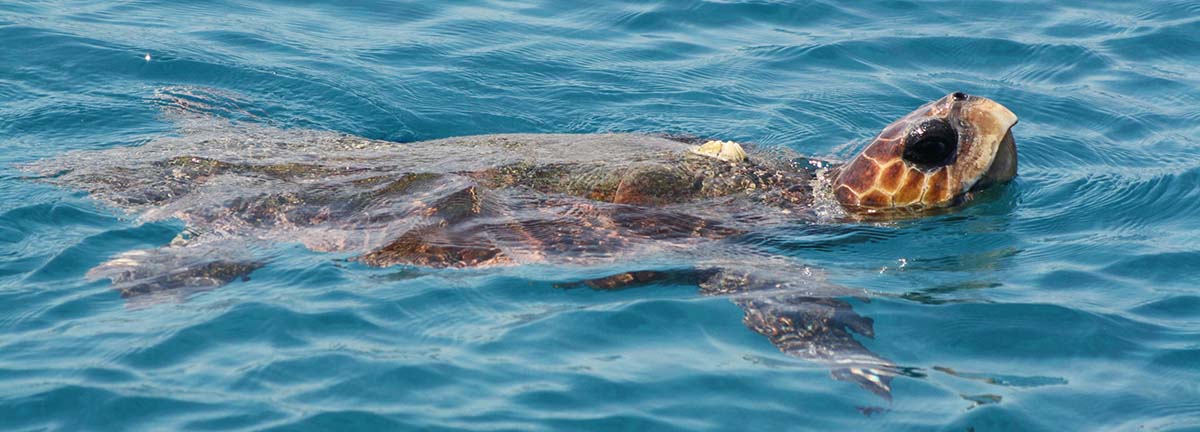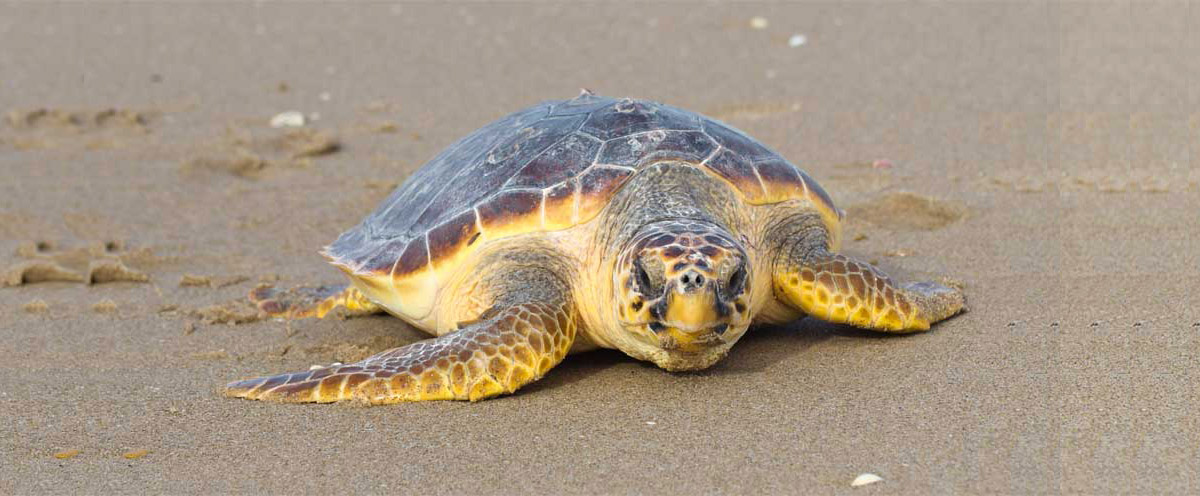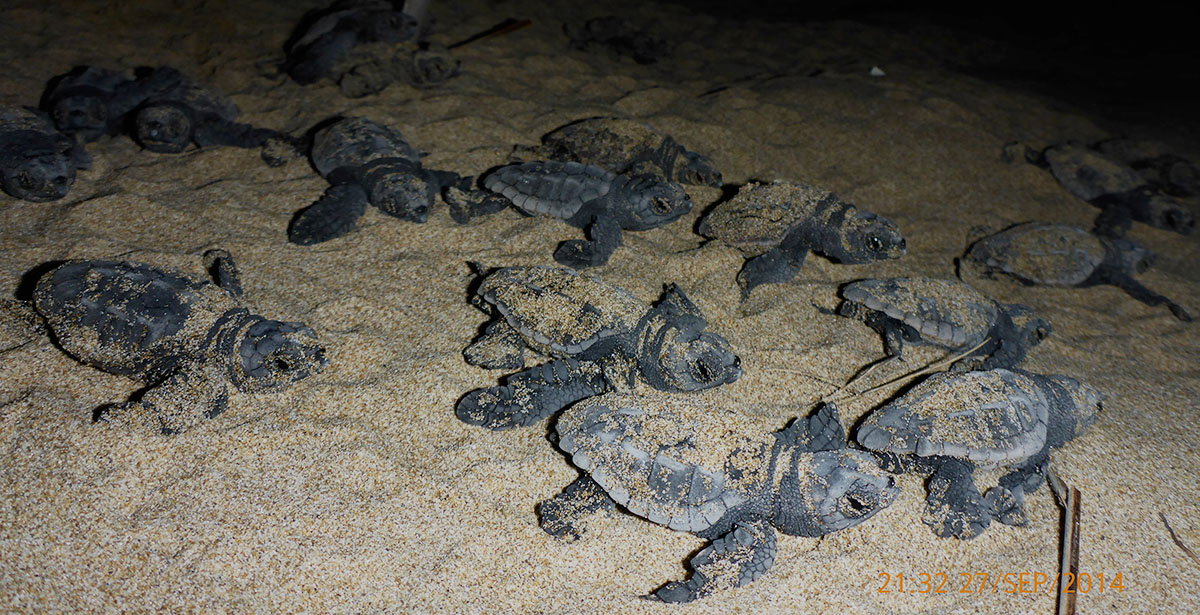 Sea turtles live in almost every ocean of the world. Their smooth shells and paddle-like flippers help them speed through the water at up to 24 kph. There are seven living species of sea turtle: Leatherback, Green, Loggerhead, Olive Ridley, Kemp’s Ridley, Flatback and Hawksbill. It is the Loggerhead sea turtle, Caretta caretta, that nests on the Greek island of Zakynthos. Although they are distributed throughout the world, 80% of the Mediterranean Loggerheads nest on the island of Zakynthos, making it incredibly important to conserve the landscape and wildlife. Worldwide, Caretta caretta in classified as endangered, but in the Mediterranean, where their situation is dire, they are Critically Endangered.
Sea turtles live in almost every ocean of the world. Their smooth shells and paddle-like flippers help them speed through the water at up to 24 kph. There are seven living species of sea turtle: Leatherback, Green, Loggerhead, Olive Ridley, Kemp’s Ridley, Flatback and Hawksbill. It is the Loggerhead sea turtle, Caretta caretta, that nests on the Greek island of Zakynthos. Although they are distributed throughout the world, 80% of the Mediterranean Loggerheads nest on the island of Zakynthos, making it incredibly important to conserve the landscape and wildlife. Worldwide, Caretta caretta in classified as endangered, but in the Mediterranean, where their situation is dire, they are Critically Endangered.
The Loggerhead sea turtle has been around for 250 million years, and was a contemporary of some of the earliest dinosaurs! They are named Loggerhead due to their large heads and powerful jaws which allow them to crush hard shelled prey. They are very important to the oceanic ecosystems, helping to maintain healthy coral reefs, sea grass beds, control jellyfish populations and can have up to 100 different species of animal and plant life living on their shells at one time.
The Loggerhead sea turtle is omnivorous which means they eat a mixture of plants and other animals. They are primarily carnivorous though, eating jellyfish (they are immune to their sting), conchs, crabs and fish amongst other marine life. They are also known to occasionally eat sea grass, seaweed and sargassum.
The Mediterranean Loggerhead sea turtle is only found in the Mediterranean. However, new studies have shown that juveniles may in fact cross the Northern Atlantic Ocean. The Loggerhead sea turtle only comes to Zakynthos for the breeding season and when winter is on its way, they swim to the northern part of Africa. The nesting season starts sometime in May (depending on the weather) and ends in July. Hatchling season runs from July to October.
PHYSICAL FEATURES
On average, Loggerhead sea turtles are around 90 cm long (35 inches), although larger specimens have been found measuring up to 280 cm in length. They have a reddish-brown shell, brownish-yellow skin, and a disproportionately large head compared to the other species. There are very few differences between male and female Loggerheads, but the easiest way to identify them is by looking at their tails; the males have longer, thicker tails than the females.
The Loggerhead sea turtle spends most of its life in the ocean, with females coming ashore every 3-4 years during maturity to lay her eggs. All sea turtles have similar basic nesting behaviours; females return to lay their eggs on or near the beach where they hatched. They haul out of the water, climb the beach, excavate a body pit, lay eggs, fill the egg chamber, fill the body pit, and finally return to sea.
 MATING
MATING
The Loggerhead turtle’s mating period may last up to six weeks. It appears that the turtles court their mates; nuzzling, biting, head movements and flipper movements are all examples of male courtship behaviour. Studies show that male Caretta caretta turtles approach the females and attempt to mount them while females resist. The male and female turtles may circle each other, and if the male has competitors, the female may leave the males to struggle with each other. The winner then mounts the female and mating begins.
Over a mating season in Zante the female Caretta caretta loggerhead turtles usually produce two or three nests. After this they become quiescent, they produce no eggs for an average two to three years. Unlike other sea turtles, courtship and mating usually do not take place near the nesting beach, but rather along migration routes between feeding and breeding grounds. In the Mediterranean, Caretta caretta loggerhead turtles mate from late March to early June. The nesting season peaks in June and July, but varies by nesting beach.
This video shows the full mating – nesting – hatchling cycle of sea turtles on an island in Malaysia.

HATCHLINGS
The sex of the hatchling is determined by the temperature during incubation. Temperatures of 29 degrees Celsius and above produce females, whilst temperatures lower than 29 degrees Celsius produces males. Most beaches in Laganas Bay produce mainly female hatchlings, whilst the islet of Marathonissi produces mainly males due to a cooler temperature.
Hatchlings average about 1.8 inches in length and weigh around 20 grams when they are born. After hatching, the baby turtles enter the sea and swim away from land for several days. The “post-hatchlings” then return to find a home rather close to shore. They may stay there for months, feeding on floating material and occasionally swimming to keep from getting too cold. Eventually, they enter ocean currents farther from shore and move into the oceanic zone where they remain until they reach the juvenile stage of their life, between the ages 7 and 12.
Only one in each 1,000 baby Loggerhead turtles is expected to survive once they make it to the open seas. With soft shells they are eaten by fish and other sea animals. They also get caught in fishing nets and are sometimes suffocated by plastic bags floating in the ocean. Those that do survive go on to move into the neritic zone of the ocean and remain there until reaching adulthood. The shallow neritic zone is also an important area for adult foraging and inter-nesting habitats.
Although Caretta caretta sea turtles cannot withdraw their heads into their shells, the adults are protected from predators by their thick shells, large size, and of course the thick scaly skin on their heads and necks.
You can write my paper for me with such turtles and know more about.
For more information about Sea Turtles check out our YouTube Channel where we’ve made playlists of some of the best Sea Turtle videos around!
